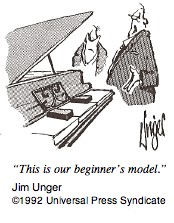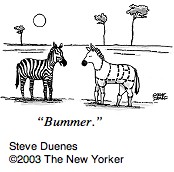Playing the ZB-6
At first, it may seemd daunting to tackle an instrument as new as a Z-Board. We have taken some steps to smooth the transition and let you use the skills you (may) have already developed for playing string instruments. By contrast, some features of the Z-Board, such as two-handed playing, will be new to (most) string players. These steps and features are discussed in the following sections.
Tunings
This topic is covered on the home page also, and is reproduced here, with some additional information.
Each horizontal row of keys gives you the notes from a single string of a conventional stringed instrument. The musical interval between each row (“string”) can be a perfect fourth (like a bass), a perfect fifth (like a violin, viola, cello, or mandolin), or the pattern can follow that of a guitar.
For bass players, one of the tunings in fourths will be the most familiar. The low string on a standard bass is tuned to E (41 Hz); for a 5-string or “extended” bass, it is usually tuned to B (31 Hz).
For guitar players, the standard guitar tuning (E-A-D-G-B-E) will be the most familiar.
For most other string players, a tuning in fifths will be the most familiar. For example, a standard violin or mandolin is tuned G-D-A-E (low to high; the G is first below middle C, at 49 Hz). Those would correspond to the middle four rows of keys on a ZB-6. This range is extended by one row below and one above, giving the full tuning of C-G-D-A-E-B. Similarly, for a viola or cello, the middle four rows will be tuned C-G-D-A; all six rows will extend that to F-C-G-D-A-E.
To increase the range of the ZB-6 even further, it is equipped with octave-shift keys. This lets you cover as wide a range of notes as is supported by the device into which you plug the ZB-6. That could be a MIDI sound module, or a computer running a software music program such as GarageBand.
In addition, the ZB-6 can be set up with separate “zones”, for example different octaves for the left and right hands. This lets you expand the range of the instrument without the need for switching the octave in the middle of a song.
In principle, the ZB-6 could be set up with any tuning imaginable. One obstacle to this is developing the interface for assigning the tuning. (Feature request; look to the future for this.) Another is that with the current design (expect future improvements here too!), the key colors are fixed, and changing the tuning arbitrarily could result in assigning natural notes to black keys or flatted/sharped notes to white keys. This would detract from the usefulness of the coloring; see the next section for more on this topic.
Key Coloring
One advantage of the interface presented by conventional keyboard instruments is the visual pattern of black and white keys, which lets the performer home in quickly on a desired note. For example, a piano player knows that D is always the key between the pair of black keys. The guitar player has a little bit of similar guidance from the dot-inlays on the fretboard. Fretless instruments often lack any kind of marking. (Of course, a violin player, for example, must learn to intone the notes correctly, and apply an appropriate vibrato.)
The ZB-6 extends this advantage to two dimensions, and reveals a larger pattern of which the piano pattern is just a one-dimensional cross-section. For example, any single row of keys on the ZB-6 will have the same pattern of black and white keys as does a piano, like so:

The user sees the same groups of two or three black keys, arranged so that the white keys comprise the C major scale.
A Z-Board player sees this pattern extend at right angles also, revealing a planar design. It is still correct to say that the note D is the white key between the pair of black keys:

But D is also the middle white key in a vertical column of seven white keys:
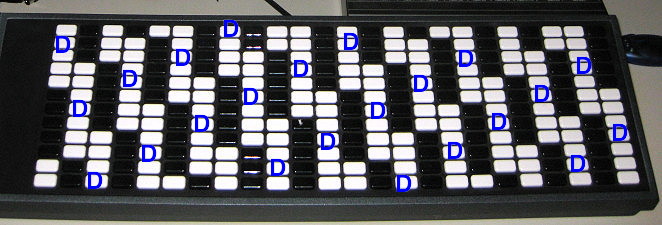
(In the six-string ZB-6, you never see the full column. In a larger Z-Board, this is visible.)
Similarly, it is still the case that C is the first white note to the left of the pair of black keys. But now it is also the lower-left white key in the 2x2 “block” of white keys. B♭ is still the right-hand key in the group of three black keys. But it is also the bottom key in the column of five black keys (in fourths tuning)
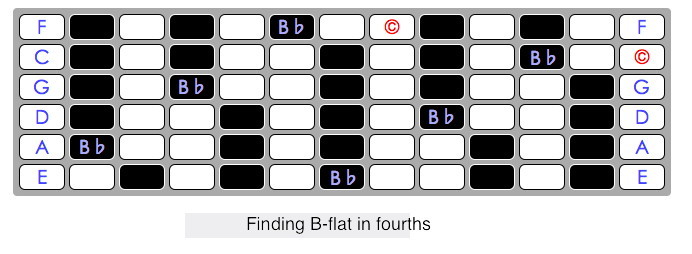
or the top key in the column of five black keys (in fifths tuning).
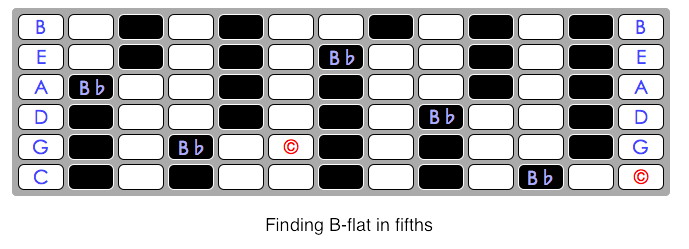
The guitar tuning is the odd one out in this set of rules, because of the irregularity introduced by the major third interval between the G and B strings. However, it is still the case that the white keys represent the C major scale, and with practice the experienced guitar player will learn the appropriate visual cues.
No “Shadowing”
In conventional stringed instruments, it is not possible to play two notes simultaneously on a single string. Fretting two notes on the same string is to no avail, since the higher-pitched note casts a “shadow” that prevents the lower one from playing. This is one of the particular advantages to the Z-Board. To play double-stops or chords on a string instrument, the musician must go across the neck. Close intervals, like a major or minor second, require a wide spread of the hands, and may not be possible in some tunings or neck positions.
By contrast, with a Z-Board the musician can play intervals or chords in both directions, horizontally or vertically. This opens up a wider range of fingering options and makes the voicing of, for example, the major second part of a dominant seventh chord, much easier to achieve.
Two-Handed Playing
This change from the familar string interface actually consists of two aspects: the different orientation of the keys and the loss of the separation of fretting and plucking/strumming/bowing.
A wide-range Z-Board, like the 12x24 key version, can really only be played in front of the musician, with both hands approaching from “below”, that is from the front or low-pitch row of keys. In this case, the hand that is normally used for fretting notes (the left hand for right-handed persons) is approaching the notes from an unfamiliar direction. Experience with learning the Z-Board suggests this is not really a difficult transition. When the tuning is familiar, the hand rapidly learns to find the desired notes.
The other hand, the hand that would pluck, strum, pick, or bow the notes on a string instrument, is already in the familiar orientation to the notes, and will quickly adapt to striking the keys.
The ZB-6 can also be played in the same sort of orientation as the Chapman Stick, by hooking one end into a belt and tethering the other end with a cord around the neck or shoulders. In this case, both hands are already in their familiar orientation.
But in any case, the musician must develop the independence of control that is already familiar (but by no means easy) to the keyboard player. This is one of the particular advantages of the ZB-6. Music that was formerly out of reach for a string player, including much of the great library of keyboard compositions, is now playable.
